EMEA Outlooks Stay Mixed into 2026: Domestic and Global Uncertainties
· In South Africa, we foresee average headline inflation will stand at 3.4% and 4.2% in 2025 and 2026, respectively, despite upside risks to inflation such as swings in food prices, supply chain destructions including energy shortages and port inefficiencies and global uncertainties. We see growth to be 1.1% and 1.6% in 2025 and 2026, respectively. Risks to the growth outlook are broadly balanced, with faster reform implementation representing an upside risk to growth while uncertainties about the U.S. and Chinese economies, tariff wars and adverse global developments could cause problems. Our end-year policy rate predictions remain at 7.0% for 2025 and 6.5% for 2026, when compared to June outlook.
· In Turkiye, the arrests of opposition mayors continue to risk the disinflationary process due to loss in investor confidence and currency volatility. We foresee upside risks to inflation emanating from domestic uncertainties, stickiness of services inflation, and adverse geopolitical impacts leading our average inflation forecasts to stand at 34.5% and 22.2% for 2025 and 2026. Inflation expectations and pricing behavior remain fragile. We think Central Bank of Republic of Turkiye (CBRT) will likely cut the rate to 37% by end-2025. We forecast the economy to expand by 3.1% in 2025 and 3.5% in 2026 considering high inflation and tighter fiscal stance continue to dent growth.
· In Russia, the Ukraine war continues to create high military spending, strong fiscal stimulus in addition to aggravation of staff shortages. The probability of war continuing remains at 70% considering peace negotiations continue to develop slowly. Our 2025 average headline inflation is 9.1% YoY due to sanctions, commodity price fluctuations, supply chain inefficiencies, and exchange rate volatility. Our end-year policy rate prediction stands at 16% for 2025, and 10.5% for 2026 as we foresee Central Bank of Russia (CBR) will continue its easing cycle unless inflation picks up and RUB loses value. We envisage growth to hit 1.3% and 1.4% in 2025 and 2026.
Forecast changes: From our June outlook, we have lifted our end-year key policy rate for Turkiye to 37.0% from 34.0% due to sticky inflation; and CBRT halted its easing cycle in Q2 due to global uncertainties and risks related to domestic politics. We decreased our end-year key policy rate for Russia from 18.0% to 16.0% since CBR started its easing cycle earlier-than-expected as inflation continued to soften after Q2.
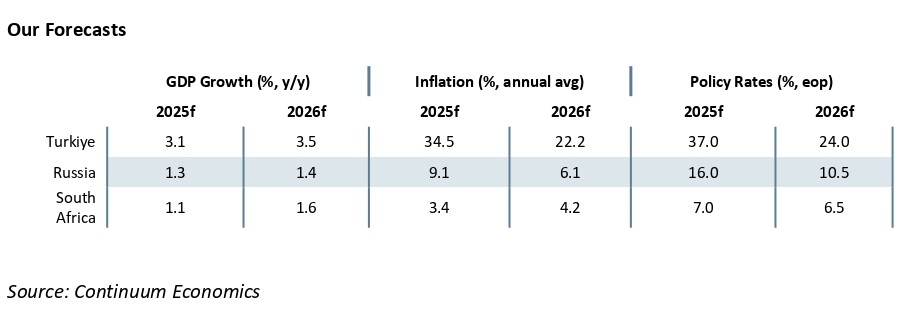
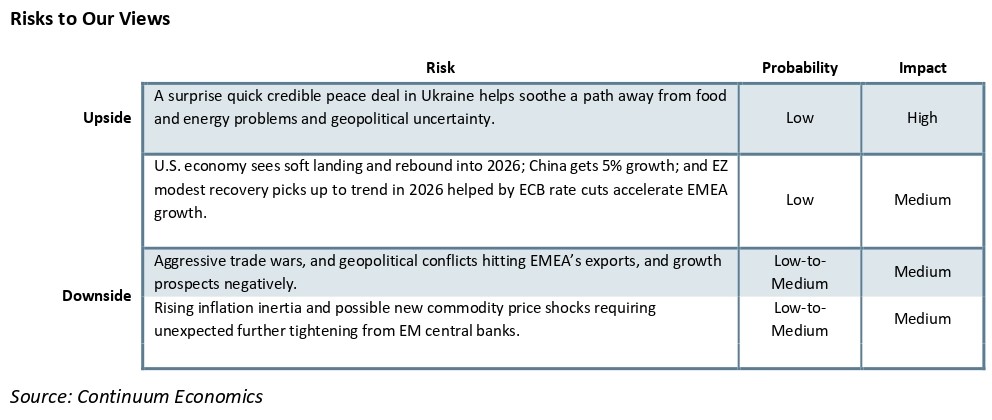
EMEA Dynamics: Global Uncertainties and Diverse Domestic Dynamics Rule
We think volatile U.S. economy, trade tariffs, country specific factors, uncertainties about Chinese economy, and adverse geopolitical developments continue to rule the EMEA outlook, and could risk greater uncertainty over the EMEA medium-term prospects. EMEA monetary easing cycles continue to differ, as progress towards inflation targets and domestic factors vary. We continue to foresee EMEA countries will see divergent growth prospects, given differing levels of U.S. tariffs and internal growth dynamics.
Inflation remains the major concern for EMEA economies since they remain elevated in Russia and Turkey while previous aggressive monetary tightening cycles are still feeding through helping inflation to follow a downward trend. South African Reserve Bank (SARB) decided to halt its easing cycle due to risks as annual inflation hit above the new 3% inflation anchor, and SARB is now assessing the impact of earlier cuts before restarting easing cycle. Taking into account that inflation started to soften in Russia after June, CBR resumed its easing cycle and reduced the key rate by 100 bps to 17% on September 12 highlighting current inflationary pressures are easing. Turkiye will likely resume its cutting cycle in Q4 2025 and 2026 unless a spike in inflation is seen and/or adverse domestic political developments occur.
We think uncertainties about the DM economies coupled with negative impacts of U.S. additional tariffs could darken the EMEA growth prospects in 2026. For EMEA countries, additional tariffs are significant headwinds for exports and capex, with the scale influenced by the scale of openness for the economies. The content and the timing of U.S.- China trade truce will also be a significant for the EMEA trajectory. (Note: We think a trade deal should eventually be reached while this will likely only provide modest relief on tariff levels and will not provide a major boost for the Chinese economy into 2026). Chinese consumption is still modest and residential property and private business investment are weak could affect EMEA exports to China. Recession is a risk in the U.S. if we see a vicious circle of weakening consumption and employment and the critical question is how much the U.S. economy is slowing down with the feedthrough of Trump’s tariffs to boost inflation and restrain GDP growth, which could worsen EMEA growth trajectories.
Peace deals in Ukraine and Gaza coupled with lowered tension in the Middle East could particularly help Russian and Turkish economies to feel relieved, though our baseline is conflicts in Ukraine and Gaza to remain during the rest of 2025 and into 2026. (Note: Our baseline view in Ukraine is war drags into 2026 (70% probability), as Putin maintains a hard line stance and talks have failed to reach a ceasefire or peace deal yet).
Figure 1: South Africa, Russia (LHS) and Turkiye Inflation (RHS) (%, YoY), January 2023 – August 2025
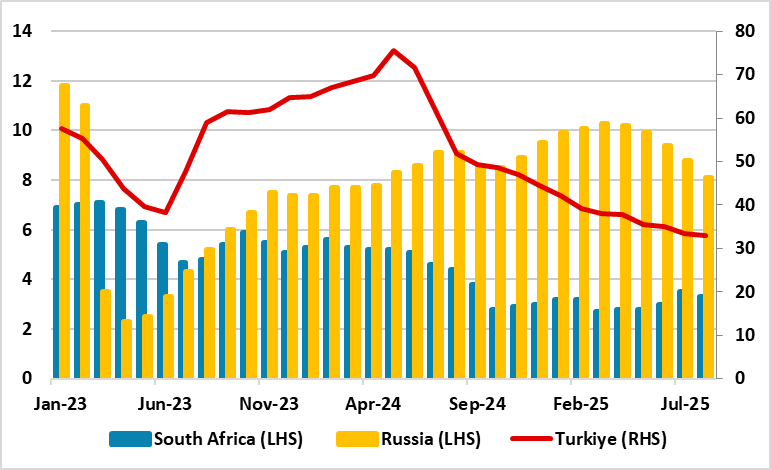
Source: Continuum Economics, Datastream
South Africa
Despite South Africa facing challenges such as declining real per capita growth, high unemployment and poverty rates, the economy continues to enjoy inflation remaining within SARB’s target band of 3% and 6%. Annual inflation stood at 3.3% YoY in August thanks to moderately slower food price growth and falling fuel costs. Despite this, there are some worrying signals about the course of the inflation heading to 2026, and we consider it is set to move over 4% in 2026 as increase in utility costs, climate-related agricultural disruptions, global commodity price shocks and ZAR volatility will likely continue to pressurize prices.
Figure 2: CPI, Core Inflation (YoY, % Change) and Policy Rate (%), December 2018 – December 2025
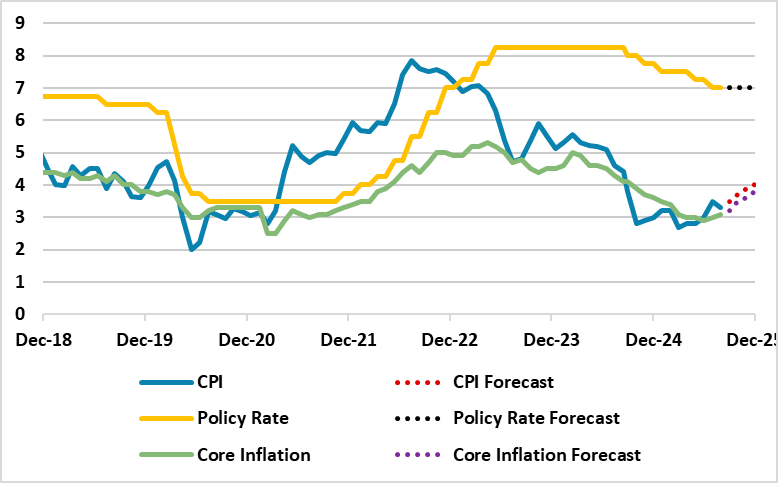
Source: Continuum Economics
We feel another risk factor for the inflation trajectory is the power cuts (load shedding) as Stage 2-3 load shedding was implemented in Q2. (Note: Eskom recently announced there has fewer load shedding since Q2, and noted that its winter 2025 period concluded on August 31 with only 26 hours of electricity cuts across four evenings, supplying electricity 97% of the time to support South Africa’s economy). Despite few load shedding in Q3, some energy analysts think blackouts are still a threat and further power disruptions are likely.
One point of good news for South Africa’s inflation outlook has been the recent drop in inflation expectations. The Bureau for Economic Research’s (BER) latest survey for the SARB demonstrates that five-year inflation expectations have slipped to 4.2% in Q3, down from 4.5% last quarter, the lowest level since 2005.
Under current circumstances, we foresee average inflation will hit 3.4% and 4.2% in 2025 and 2026, respectively, supported moderately by lagged impacts of previous tightening, and a relatively stable ZAR. We believe the key for the inflation trajectory will be the global developments, tariffs, oil prices and government’s determination to address the electricity shortages, logistical constraints and financing needs. Global uncertainties such as 30% additional tariffs over South Africa is a threat confirmed by SARB who said the impact from the tariffs on growth and inflation could be modest, which is yet to be viewed in official data. However, it is worth mentioning that this is disinflationary, as it would hurt South Africa exports and output/employment.
SARB held the policy rate at 7.0% during the MPC on September 18, as annual inflation in August hit above the new inflation anchor coupled with surging core inflation. We foresee cautious and data-dependent SARB will likely try to bring inflation down to new 3% anchor and assess the impact of earlier cuts before restarting easing cycle, particularly considering current geopolitical uncertainty and upside risks to the inflation outlook prevailing. Thus, SARB will likely halt its cutting cycle Q4. We expect SARB will continue reducing the rates in 2026, -with a slower pace due to global uncertainties-, and cut by 25 bps in each half of 2026. Our end-year key rate predictions remain at 7.0% and 6.5% for 2025 and 2026, respectively, which could also go below 6.5% if the inflation trajectory allows. We believe 3% inflation target could complicate easing in 2026, given our inflation forecast. Political uncertainty, slow reform implementation, and fiscal slippage pose internal risks.
Figure 3: SARB Interest Rate Forecast (%), 2018 – 2027
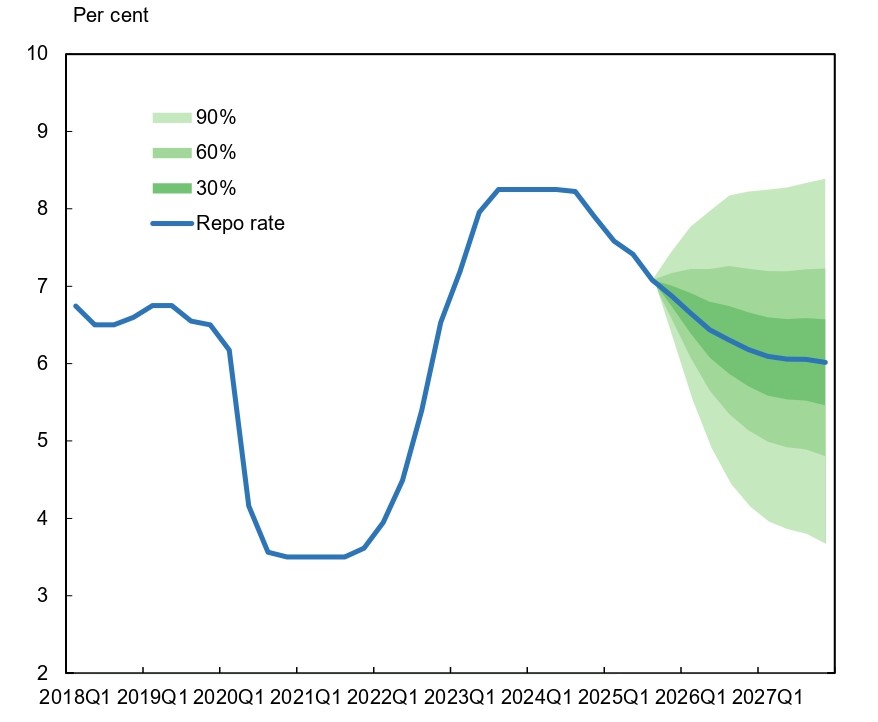
Source: SARB Forecast Report (September 2025)
South African economy grew modestly by 0.6% on a year-on-year basis in Q2 2025 supported by driven by strong performance in the manufacturing, mining, and trade. The growth momentum continued to be backed by moderate inflation, investor confidence and interest rate cuts.
Despite the positive outlook, SARB Governor Kganyago recently highlighted the country’s vulnerability to global risks, and noted that dysfunction in administered prices undermines purchasing power and weakens growth. We assess the economy will grow by 1.1% and 1.6% in 2025 and 2026, respectively, buoyed by improved consumer sentiment, no big inflation shocks, more stable electricity supply in Q3, and interest rate cuts; despite the uncertain global environment, geopolitical tensions and slowing global demand being important downside risk factors. Domestic factors such as persistent structural challenges such as unemployment and fiscal strain will continue to temper the outlook.
Unemployment remains stubbornly high at around 33% in South Africa which require urgent labor market reforms to unlock inclusive growth. We think continued implementation of Operation Vulindlela reforms - targeting energy, logistics, water, and digital infrastructure – will also be key to unlocking productivity and competitiveness.
Turkiye
Despite decelerated less-than-expected, inflation in Turkiye continues to soften in H2 backed by lagged impacts of the tightening cycle, relative slowdown in credit growth, and tighter fiscal stance. CPI cooled down to 32.9% YoY in August, marking the lowest rate since November 2021 while education and housing prices lead the rise in the index. Despite headline inflation easing, core inflation remains sticky due to structural price pressures in food, housing, and services. We expect softening to continue, but with a slower pace in Q4 while the extent of the decline will be determined by TRY volatility, food inflation, services prices and global developments. (Note: According to a recent announcement, CBRT also expects inflation to stay higher-than-expected in Q4). We think volatile food and energy prices pose upside risks to the inflation trajectory.
Despite the CBRT forecasting the annual headline inflation will stand between 25%-29% at the end of 2025, we foresee the annual average headline inflation will hit 34.5% in 2025. (Note: According to CBRT’s inflation report dated August 14, CBRT maintained its end year-end inflation forecast at 24% while increasing 2026 forecast to 16% from 12% and end-2027 forecast to 9% from 8%). We anticipate the wage-inflation spiral, deteriorated pricing behavior, stickiness of services inflation, and geopolitical risks will keep inflation pressures alive in 2026. If the Ukraine-Russia war will come to a surprising end, this will be positive for Turkish inflation outlook, while this is not our main scenario.
We envisage it will be difficult to grind sticky inflation from 30%s to 10%s rapidly, taking into account that inflation has become stickier and requiring high interest to remain for some time. It appears it would be necessary to make concessions on growth to achieve inflation in the 10’s. We anticipate domestic and geopolitical risks will keep inflation pressures alive for a longer period, and it will be unlikely to reach a single digit inflation by 2027.
It is worth emphasizing that the arrests of opposition mayors including Istanbul, Adana and Antalya in 2025 continue to risk the disinflationary process due to loss in investor confidence and currency volatility. We feel TRY remains exposed to global risk sentiment and domestic political shifts, while a sudden depreciation could easily reverse disinflation gains. Inflation expectations and pricing behavior remain fragile.
We expect a cautious CBRT will continue its cutting cycle in Q4 2025 and 2026 unless there is a sustained surge in the underlying trend of monthly inflation is observed and heightened political instability. Our end year key rate prediction for 2025 and 2026 stand at 37% and 24%, a bit higher than the June outlook due to sticky inflation and given the fact that CBRT halted its easing cycle in Q2 due to risks related to domestic politics. We are of the view that the CBRT will continue cutting rates in 2026 to 24%, but with a slower pace. We expect the monetary easing cycle to support a continued normalization of funding cost towards the policy rate.
Another major issue related to CBRT is its creditworthiness. Taking into account that sustained economic recovery hinges on the independence of the CBRT and rule-of-law reforms, we think any backsliding could easily trigger market volatility. There is serious domestic criticism about the credibility of the CBRT since the actual inflation continues to significantly deviate from the CBRT’s targets and CBRT’s decisions are controlled by the current government, particularly in the last five years, causing CBRT’s forward communication to be weak and discredited.
Figure 4: CPI, Core Inflation (YoY, % Change) and Policy Rate (%), January 2015 – December 2025
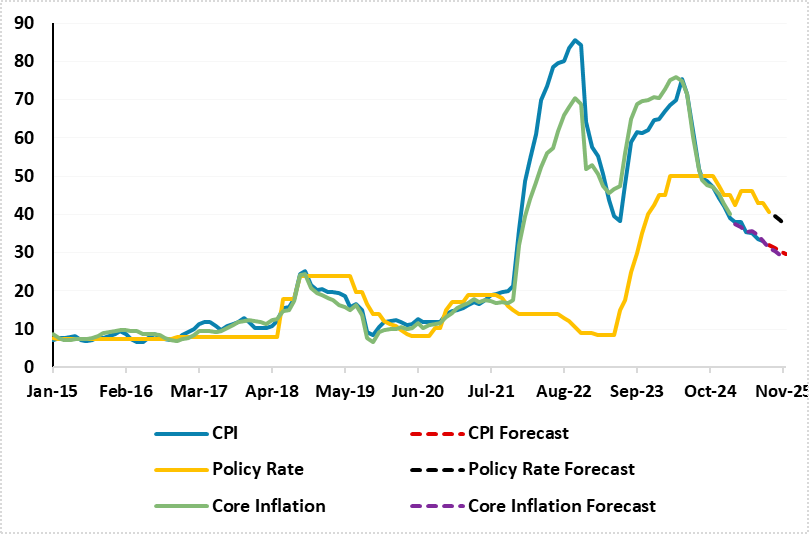
Source: Continuum Economics
We expect Turkiye’s GDP growth to edge down to 3.1% in 2025. We think aggressive monetary policy, high inflation and tighter fiscal stance will continue to moderate household consumption, lending and investments. Growth will remain under pressure in Q4 2025/Q1 2026 due to high interest rates and adverse global outlook. Additionally, adverse geopolitical developments including continuation of Russia-Ukraine conflict and the 15% additional tariffs by the U.S. on Turkiye-origin products are other risks factors.
There is still a downside risk that growth can be lower than expected, particularly considering all tightening measures in place. We believe that any unexpected resurgence of inflation, TRY depreciation, or (new) geopolitical tensions could derail recovery and reignite macro instability.
2026 growth will be likely be higher than 2025, hitting 3.5% YoY in 2026, likely supported by positive impacts of the rate cuts and increasing business confidence assuming no dramatic impact from weaker external demand. We think a drop in the inflation rate and rate cuts could boost confidence, coupled with accelerated structural reforms, and stable global conditions could lift growth back toward potential of 3.5%-4% after 2027.
Figure 5: GDP Growth (%, YoY), Q3 2022 – Q2 2025
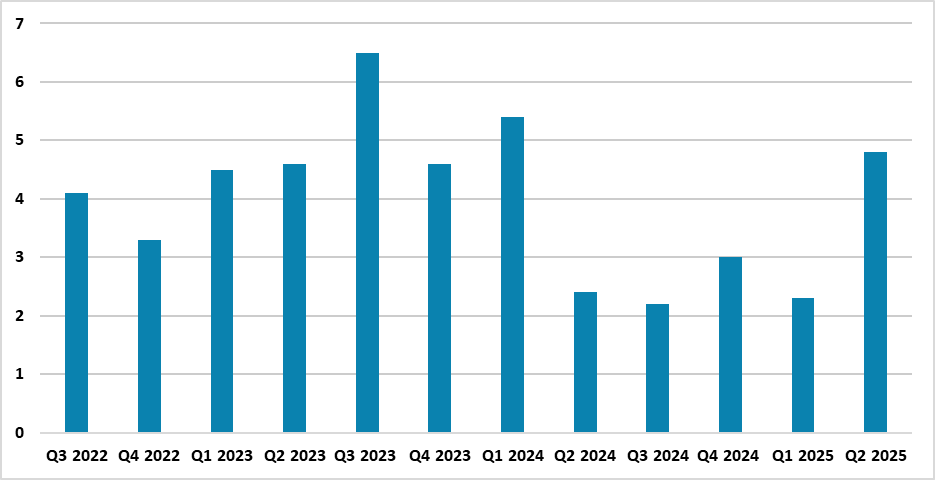
Source: Continuum Economics
Russia
Russian economy continues to face structural challenges; from sanctions and supply chain disruptions to demographic decline and fiscal pressures. The war in Ukraine remains determinant for all outlooks as it creates an increasing financial burden and labor constraints on Russia. The overall environment for doing business in and with Russia remains unfavorable.
Despite CBR projecting that inflation returns to the 4% target in 2026, headline inflation hit 8.1% YoY in August staying far from the target. (Note: We feel a full-scale peace deal in Ukraine is required for a continued significant inflation slowdown which could lower Russia’s military spending and relieve price pressures). Our average inflation predictions are at 9.1% and 6.1% in 2025 and 2026, respectively, as sanctions dominate the economy igniting labor shortages, and supply-chain disruptions. Additionally, there are constant surges in services and food prices, which is worrisome.
Despite concerns, inflation moderately edged down in Q3 as previous tight monetary policy affected bank lending and private consumption, and the RUB has shown relative resilience, particularly after June. As noted, high military spending and rising wages do not signal a continued inflation slowdown in the horizon yet, and we believe reaching 4% target will be very tough even in 2026, since cooling off inflation will take longer than the CBR anticipates.
Backed by softening inflation, CBR continued its easing cycle in Q3 and reduced the key rate by 100 bps to 17% per annum on September 12, highlighting inflationary pressures continue to decline. We think CBR will likely resume cutting rates (moderately) in 2026 if the inflation trajectory allows, RUB stabilizes and inflation expectations converge to CBR’s forecasts. We decreased our end-year key policy rate from 18.0% to 16.0% when compared with June outlook since CBR started its easing cycle earlier-than-expected after inflation started to soften in Q2. Our 2025 end-year key rate forecasts stand at 16%, and 10.5% for end-2026.
The inflation trajectory and rate decisions will depend on how peace negotiations in Ukraine will proceed in Q4 2025/2026. A full-scale peace deal in 2025 is unlikely due to president Putin’s stubbornness as he is insisting on his own peace terms. (Note: A peace deal could have helped Russian economy to feel relief since RUB will likely strengthen, average headline inflation will soften, and fiscal pressure will ease, particularly if sanctions will be lifted). The probability of war continuing remains at 70% considering peace negotiations continue to develop very slowly, Putin maintains a hard line stance and there are no significant moves yet by president Trump such as implementation of secondary tariffs on Russia oil buyers.
We continue to think Ukraine remains in a weaker negotiating place and, at some point Ukraine will have to admit giving up some land to Russia and stop insisting on joining NATO. Our second scenario is based on a Russia-friendly peace deal (30% probability) with Russia annexing areas in and around four Ukrainian oblasts that it occupied, securing no NATO membership for Ukraine and no foreign troops in Ukrainian territory.
Figure 6: CPI, Core Inflation (YoY, % Change) and Policy Rate (%), January 2015 – September 2025
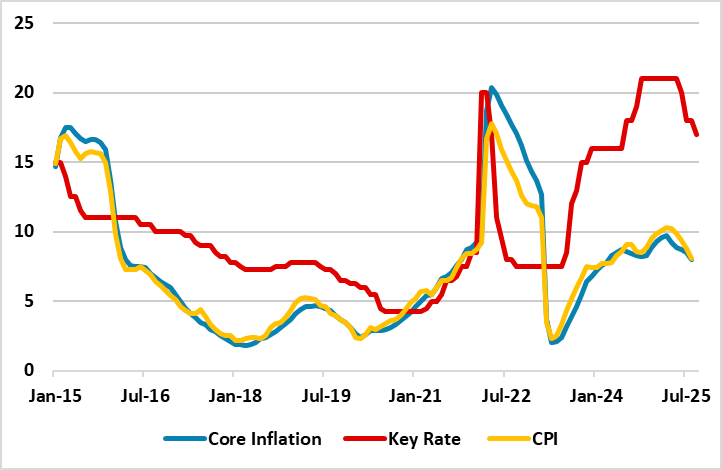
Source: Continuum Economics
When it comes to growth, the main driver for Russian GDP growth remains the surge in military spending, supported by the improved consumer demand amid greater outlays on social support, higher wages and strong fiscal stimulus. Despite sanctions, Russia maintains energy export flows to non-Western markets, particularly China, India, and parts of Africa. Despite these underpinnings, Russia's GDP expanded by 1.1% YoY in Q2, partly due to gradual slowdown in domestic demand growth, marking the slowest pace of growth since the economy resumed expansion in Q2 2023.
We envisage growth to hit 1.3% and 1.4% in 2025 and 2026, respectively, which are significantly less than 2024 figure, as the aggressive tightening cycle is still feeding through, capacity utilization reached its maximum in years, and labor force deficit is unlikely to change in the short term. More importantly, sanctions, high interest rates, supply side constraints and higher price pressures remain restrictive. It is worth mentioning that population aging and emigration are shrinking the labor force, undermining long-term growth potential in Russia.